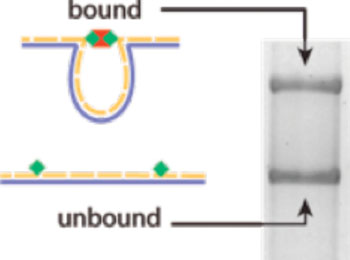Low Cost Platform for Studying Molecular Interactions Based on DNA Gel Electrophoresis
By LabMedica International staff writers
Posted on 19 Feb 2015
A novel platform for studying molecular interactions is based on the separation of linear and circular forms of DNA by gel electrophoresis.Posted on 19 Feb 2015
Investigators at Harvard Medical School (Boston, MA, USA) devised a system that used "nanoswitches," strands of DNA onto which molecules of interest were strategically attached at various locations along the strand. Interactions between these molecules, such as binding of a drug compound to its intended target or binding of a protein to its receptor on a cell, caused the shape of the DNA strand to change from an open and linear shape to a closed loop. DNA that had morphed into a closed loop form was easily separated from linear DNA by gel electrophoresis.

Image: Programmable, self-assembled DNA nanoswitches serve both as templates for positioning molecules, and as sensitive, quantitative reporters of molecular association and dissociation. The figure depicts gel electrophoresis separation of linear and closed loop DNA strands (Photo courtesy of Harvard Medical School).
The investigators demonstrated this low-cost, versatile, "lab-on-a-molecule" system by characterizing ten different interactions, including a complex four-body interaction with five discernible states. This study was published in the February 2015 issue of the journal Nature Methods.
"Bio–molecular interaction analysis, a cornerstone of biomedical research, is traditionally accomplished using equipment that can cost hundreds of thousands of dollars," said senior author Dr. Wesley P. Wong, assistant professor of biological chemistry and molecular pharmacology at Harvard Medical School. "Rather than develop a new instrument, we have created a nanoscale tool made from strands of DNA that can detect and report how molecules behave, enabling biological measurements to be made by almost anyone, using only common and inexpensive laboratory reagents."
Related Links:
Harvard Medical School









 Analyzer.jpg)




